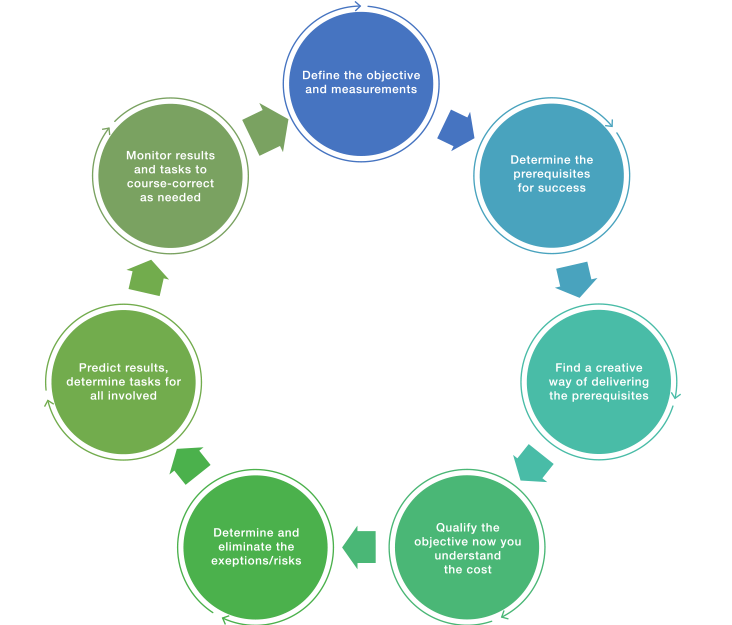The best way to plan for any outcome is to reverse engineer, rather than rely on “best efforts” or even worse “stimulus response”. It is much like a child’s maze. If you start at the exit it is easy to draw a path to the beginning. Once you have a path, you can also predict how long the journey will take and have surety of success. Conversely the traditional approach can land you in dead ends, take too long or result in an entirely different outcome.
Reverse engineering any outcome involves these steps:
This is a cyclical process and each step is cyclical in itself.

The first step is to set objectives, preferably ones that seem a big stretch at first glance, be they change, problem resolution, profit expectations or service levels. Unless a clear outcome objective is set, a strategy’s ability to deliver cannot be measured.
Once an objective is set it is important to surface the prerequisites for that outcome. Designing a creative way to deliver those prerequisites is the key. Business is a flow system, the product is value and the production line stretches from your suppliers’ suppliers to your customers’ customers. Creative solutions are aimed at alleviating or exploiting the systemic constraint and optimising the flow of value through the system.
Once a solution is found, it is possible to determine the cost of such a solution and qualify the original objective in terms of Rate of Return on Investment (RRoI), or in the case of Public Sector, Service Level Improvement at a given operational cost, and adjust accordingly. This is why it is important to go through several qualifying cycles (they don’t need to be lengthy) rather than pursue one path to completion before verifying its efficacy.
The most critical part of any plan is to deliberately identify the risks, exceptions or conditions under which the desired outcome would not be achieved. This is a different way of looking at the prerequisites, but a lot easier. By adjusting the solution or tactics to eliminate risks and exceptions, identifying any remaining, and managing them through a deliberate exceptions management process, the business is able to significantly reduce its overall risk profile. Businesses have risks, some are known and some are unknown. Deliberately surfacing them, eliminating as many as are justifiable and proactively managing and budgeting for exceptions reduces a business’ net risk position.
It is easier to predict the future results of a change than most people think, especially once the flow has been understood sufficiently to identify the constraint. The strategy then needs to be translated into tactics, the tactics into tasks and the tasks need to be completed within specific time frames in order to deliver milestone results at regular intervals.
By identifying the sequence of those tasks, the lead time on results can be determined. The business now has tangible measurements for success, rather than looking at the performance of individuals or local efficiency in the mistaken expectation that if these areas are improved bottom line results will necessarily improve.
The first problem with any plan for change is that it could be wrong. Issues, unexpected results or even new opportunities either indicate a need to adjust the strategy, or the application of that strategy. By predicting results and the expected timing of milestone achievement, the business is able to correct its direction quickly, minimise waste and reduce the business risk position to less than a traditional reactive, best efforts, or “better the devil you know rather than the devil you don’t” approach. Short planning, implementation and review cycles are best.
Copyright © 2020 All Rights Reserved by Deus Ex.